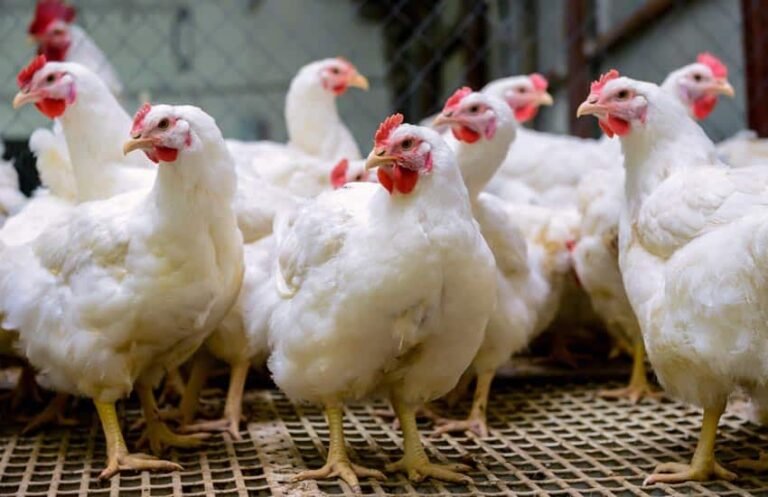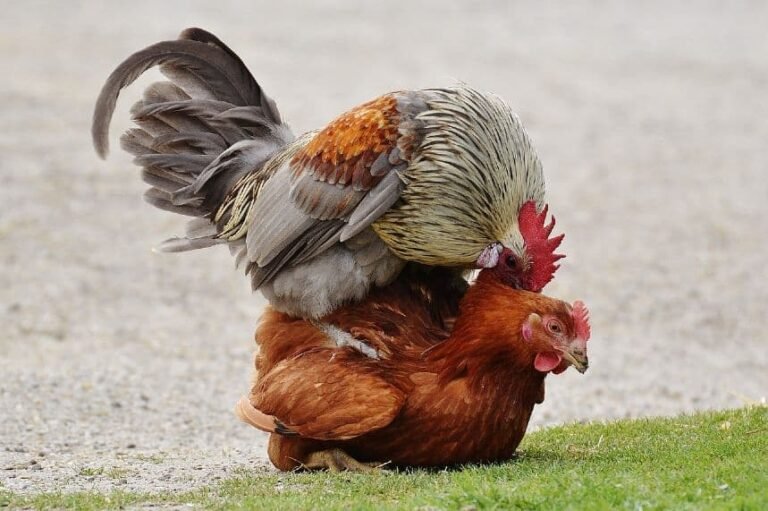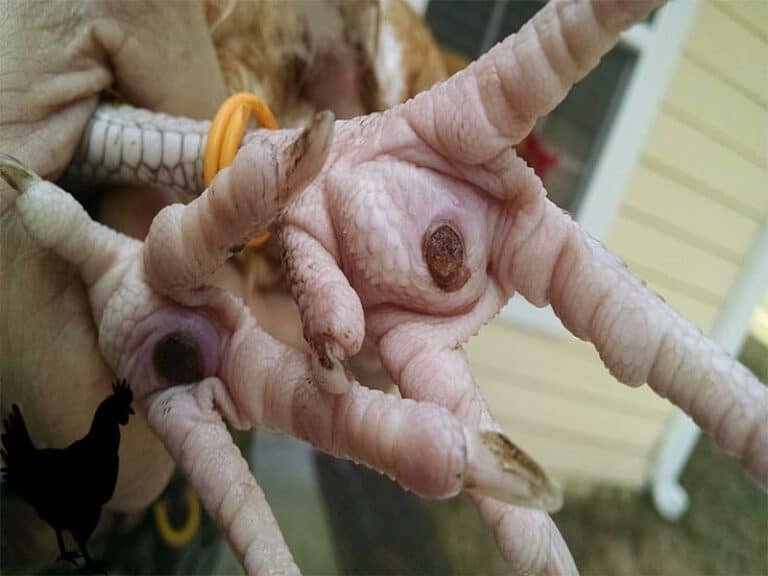Simple Ways To Determine The Age Of A Chicken

Does it interest you to know the age of your chicken or do you what to learn how to determine the age of a chicken?
I understand how challenging it can be because chicks don’t come with birth certificates.
However, there are some ways and things to look out for in your chicken that can give you a clue of how old your bird is.
In this article, you will learn about the visual cues to look for at different stages, as well as behaviors that come with different developmental stages.
So, ensure you go through this entire article to get the practical hands-on methods for determining a chicken’s age.
That said, let’s get into details.
You may also like to learn about the Top 10 Chicken Breeds That Lay Large Eggs [With Pictures]
How to Tell the age of a Chicken
To tell the age of a chicken here are a few things to look out for from when it hatches until adulthood;
- the chicken plumage,
- body size,
- combs & wattles
- legs and vents
- chicken behavior
These features are different in the 3 major developmental stages a chick normally goes through from when they hatch to adulthood.
In order for you to determine how old your chicken is, you need to know the physical differences they undergo during every one of their developmental periods.
Below are the three major development stages on how you can determine the age of your chickens.
Chicken Development Stage 1: Baby Chick (0-12 weeks)
At this stage, your baby chick will begin to develop every part of its body gradually and this stage of its life normally lasts till 12 weeks.
Below are the body developments to look out for.
Read this article to learn How To Care For Day-Old Chicks

1. Plumage
From the moment your chick hatches till they get to day 6, it’s naturally covered with a fine down coat that’s yellowish in color.
They will literally not have any feathers at all, and won’t really be looking cute until after a week which is the 8th day.
Now, from day 8, little feathers will begin to appear showing the wing tips, and as such will last for six weeks.
Following that, during the seventh week, the Male chick will start to grow long pointed features, usually around its neck, saddle, and tail.
These types of feathers are called the hackle, saddle, and sickle feathers.
While the female chick will start growing ground feathers that are not of the same length (long and short) but are usually round at the end.
However, the female chick does not have the hackle, saddle, and sickle feathers.
That said, their second to final mini molt stage will be around this seventh week up till the twelfth week.
Now let’s look at the body.
2. Body Size
During the hatching stage, your chick’s weight will be around 1.4oz (40 gram) same size for all.
For the next 12 weeks, they will put on a reasonable amount of weight. Where the chicks will weigh 2lb 6oz (1.1kg).
Although, their body is going through a lot of changes whereby their cute fuzzy look is turning into a slender gawky teenager.
Don’t fail to read about these 17 Largest Chicken Breeds in the World (With Pictures)
3. Combs and Wattles
Know that when your chick hatches their combs and Wattles will be small.
Although, the make chick might have noticeable and largish combs when they hatch. But you will not be able to notice their Wattles at this stage.
When they get to week twelve, you will begin to notice a very clear difference in the combs and wattles.
Because at this stage they are quite obvious and start to turn red. However, the combs and Wattles will not be energetic.
Also, during week 12, you will be able to differentiate between the male and the female.
Here, the boy chick has more developed combs and wattles than the girl chick.
4. Legs and Vent
When your chick hatches their legs will look strong and skinny. But, by the twelfth week they will start looking thick whereby
that of the boy chick is more noticeable than the girl chick.
At this stage, some breeds that are yellow-legged such as the ISA Browns will become noticeable.
For the vent area, nothing is noticeable at this stage.
5. Behavior
At this stage, they usually do not show much in their behavior as they are still coming up.
However, as they grow you will begin to notice the changes in their behavior as the boy chicks will start bumping each other’s cheeks while the females will start posturing.
The boy chick starts a pecking order of the group, becomes more outgoing, tends to stand taller, and is usually pushed to the front of the group.
Sometimes at this stage, they might even start challenging you, and also by week 7-12 they might start crowing.
While the girl chicks are usually more reserved, like to stay at the back of the group, adopts a more submissive posture, and are always quiet than the boys.
With their behavior, you should be able to differentiate the Male and the female at week 12 if you have been observant enough.
So, when you notice all these signs you will become sure that your chick is still small.
You will definitely love this article about the 17 Friendliest Chicken Breeds in the world (With Pictures)
Chicken Development Stage 2: Teenage (pullet and cockerel 12-52 weeks)
Another way to determine the age of your chick is, from 12 weeks, your chicks are starting to become teenagers. As a result, they tend to appear not so cute and look awkward.
By now they are growing their adult plumage (feathers) which will have to stay with them for a year before they start molting and growing new feathers.
At this stage also for the young rooster, their plumage marking will become more visible throughout the first year.
The hackle feathers on their shoulders will look more pointed and flow down to the ground.
While the saddle feathers cover his side as well sloping down. Then the sickle feathers will start taking a notable appearance at this point.
Here are the major body changes to look out of in teenage chickens;

1. Body Size
Your chick’s body size at this stage will only continue to grow and fill up its frame into an adult (Hen or Rooster).
This is another way to determine the age of a chicken by paying attention to its body size.
From 20 weeks, most of your chicken’s adult body will be more revealing. For example, a Rhode Island Red weight will be around 3.1lb (1.4kg).
While other breeds will continue to grow until 9 months. As a result, their body starts to look like an older hen and rooster having a more solid and rounded frame.
2. Combs and Wattles
In their teenage stage, your hen’s combs and Wattles will begin to turn red and flesh out while she is approaching the point of laying.
Here also you can use the combs and Wattles to determine the age of your chicken.
The reddening that shows up on the combs and wattles at this stage is a signal to the rooster that she is getting to the stage of mating.
While for the roosters, their combs and wattles will become large and red. He shakes them when he crows to attract the females.
When the combs and Wattles of both the hen and rooster are looking vibrant it’s a sign of good health.
3. Legs and Vent
Their legs will be fully colored at this stage looking strong and smooth. But, if it’s looking more than expected for a young chicken, then you have to look into it.
As for their vent, a pullet that has not started laying eggs, her vent will look round, small, dry, and pale.
From 20 weeks the young roosters are ready to mate while the young hen might not be ready at this stage.
Aside from that, looking at the vent can also help you determine the sex of your chicken.
You can also measure the distance between your pullet’s pelvic bone on either side of the vent.
Usually, before she starts laying eggs the distance is about 2 fingers wide.
However, immediately after your hen starts to lay eggs its vent turns pink.
But have it in mind that their first couple of eggs is usually small.
4. Behavior
The female chicken will start showing signs of submission which then leads to her squatting down indicating to you that she is ready to receive a rooster.
She might as well start showcasing some nesting traits. For example, she starts checking out nesting boxes and areas that will be suitable for her to lay eggs.
When she starts laying eggs, she may appear uneasy and sometimes confused. This is normal at this stage.
Because her hormones are beginning to play tricks on her and she really does not understand what is going on.
Also, at this stage, the first sets of eggs are always small until her egg machinery is properly formed.
Once she comes to an understanding of her nature she becomes more settled in her behavior.
On the other hand, the cockerel at this stage is usually a pain in the neck as there is always a challenge among the young roosters on a daily basis.
They also start chasing the young hens to mate thereby causing some nasty injuries to the pullet.
This is the stage where you have to separate them into different quarters to prevent your young hen from getting hurt.
These are the things to look out for in order for you to determine the age of your chicken when they are at the teenage stage.
Now, check out this article about How to Take Care of Chickens [Beginners guide]
Adult (Hens and Roosters 1+ year)
The following are some things to look for in order to determine if your chicken is now an adult;

1. Plumage
From 12-18 months, your female chicken (a hen) will experience her first full molt.
During this period her old and worn-out feathers will fall out in order for them to get replaced by new ones.
The purpose of these new feathers is to keep her warm and dry at night in order to make her more appealing to the rooster during mating season.
So, with these signs, you will be able to determine the age of your chicken.
2. Body size
Another thing to look out for in your chicken inorder to determine if it’s now an adult is that by this time they must have gained full weight.
At this stage, your pullet will change from a slender chicken body into a homely hen. Whereby her shape will become more round and soft.
While your young cockerel will develop into a more masculine and upright rooster at this stage.
3. Combs and Wattles
Also at this stage your chicken’s combs and Wattles appear to be more plump and fuller than that of a younger chick.
Another physical sign to look out for is, at this stage the color of the combs and Wattles will fade out into a washed out red or pink color.
This happens to the female chicken and the vibrancy will only return when she is ready to lay more eggs in future.
Don’t fail to also read this article about the 12 Best Chicken breeds for Eggs – chicken breeds for eggs
4. Legs
Again, when your chicken approaches their full molt the color of its leg will begin to fade into a pale beige color.
This normally happens during the laying period because the coloring on the leg helps in keeping the yolk color orange.
By the next season of laying the color will come back to normal.
Also, their legs become rougher as they age and some scales might start lifting slightly.
You will also begin to notice that the claws of your older hen start looking longer, which is another way for you to determine the age of your chicken.
5. Vent
As your hen gets to her full molt the vent will become well rounded but the pinkness will fade out.
An adult hen that’s not in its laying period will have a yellowish vent that looks pale and dry until the next laying cycle.
While the Male chicken (roosters) can be in a good mating condition for up to 3 years.
After this period his sperm count reduces as he will no longer have an interest in mating anymore.
6. Behavior
In order for you to determine the age of your chicken, you will notice that the hen becomes calmer at this stage.
Because she is now used to the hormonal changes in her body and understands her place in the pecking order.
Although depending on the breed, sometimes the girl chick might not be prone to being calm.
While the rooster is always alert and watchful at this stage and he takes the job seriously.
The head rooster will always be first to crow as other roosters in the flock will be submissive to him.
These behaviors by your chicken will help you determine their age as an adult.
People who read this article also read; Chicken Diseases: Causes, Symptoms, Treatment and Prevention Tips.
Conclusion
If you hatched and nurtured your chickens yourself, you can tell how old they are. However, if that is not the case, the next best choice is to learn how to tell a chicken’s age.
You can tell if you’re looking at a younger or older chicken by looking at the coat, feathers, legs, combs, and body size.
Also, you can obtain an idea of the bird’s age by watching how they walk and how they behave.
As you read over the above indications and tips for detecting the age of a chicken, they will aid your general knowledge of how to determine the age of a bird.
However, some breeds might age differently, so do your best to find out their characteristics and behaviors.
Frequently Asked Questions
How can you tell a 4 weeks hen from a rooster?
At this stage, the Male chick usually has pointed-looking feathers while the female chicken will have rounded feathers.
Also, there is a difference in their behavior as the rooster will always want to be in front of the group while the hen will always want to lay back.How can I tell how old my chickens are?
You can tell how old your chickens are by looking at their feathers, the colors of their legs, and their behavior.
From 0-12 weeks they are looking very small and fuzzy cute, they weigh about 1.1 kg, their legs are looking skinny and you can barely notice their vent.
Now from 12-52 weeks, they look awkward with their feathers coming out and covering their sides.
They start to increase in weight having a more solid and rounded frame, and the combs and Wattles of the hen become red and flash out.
While the combs and wattles of the rooster also turn red and look larger. Also, the vent of the hen is getting ready to lay.
The behavior of the hen becomes more homely while that of the cockerel becomes more aggressive and challenges its other roosters.
From 1 year and above, your chicken must have gained full weight, and gotten to its full molt, combs, and Wattles looking fuller.
The colors on their legs are looking more faded with the hen having a more calm nature and the rooster still looking out for the group and the leader.At what age do roosters start mating?
They usually start matting early before the hen and it’s usually during 4 to 5 months.
What is the lifespan of a chicken?
Chickens live for about five to 10 years on average.
However, there are a number of factors that can influence how long your chicken lives.
As a result, each chicken’s life expectancy will be different.
The breed of a chicken is one of the most important elements in determining how long it lives.
Some breeds have a longer lifespan than others.At what age do chickens start laying eggs?
The majority of chickens begin to lay eggs when they are about 16-20 weeks old.
Although some breeds take longer than this before they start laying eggs.What do 6-week-old chickens look like?
They usually have a fuzzy cute look, not having much weight with their legs looking skinny.
References
- Petkeen.com – How To Tell The Age Of A Chicken (With Pictures).
- ChickensandMore.com – 3 Simple Ways To Determine The Age Of A Chicken.





